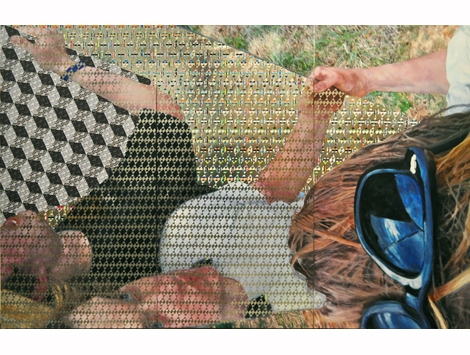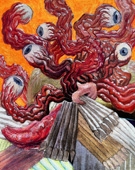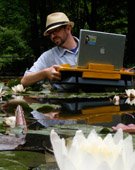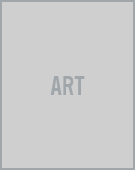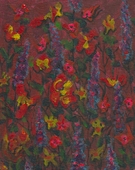It's a painting of twins standing back to back and holding mirrors. The actual mirrors in the painting create a twin of the viewer by reflecting his or her image, and therefore the painting becomes a situation of viewing where the viewer is incorporated into the narrative of the painting.
Full Description
Acrylic, Mirrors, and C-Prints on Canvas. 96x144". 2011. Collection of Jonathon Carroll.
Work metadata
- Year Created: 2012
- Submitted to ArtBase: Monday Jun 4th, 2012
- Original Url: https://www.artspan.com/images/other_member_pics/lanceturner/Paradise%20with%20Lawnmowers.jpg
-
Work Credits:
- lanceturner, primary creator
Want to see more?
Take full advantage of the ArtBase by Becoming a Member
Take full advantage of the ArtBase by Becoming a Member
Artist Statement
The in painting’s title, Paradise with Lawnmowers is a reference to the Talking Heads song "Nothing but Flowers". The rest of the title suggests that this is a simulated spectacle in a utopian non-space. The image depicts two twins standing back to back and holding mirrors. They are the lawn mowers, which suggests that they create and destroy the paradise that they inhabit, which parallels the capturing and inhabiting of the sublime landscape throughout the history of American pastoral paintings such as Thomas Cole‘s “The Picnic“. Of course I arranged for this situation of paradise and lawnmowers, so it also represents my idea of the situation, and it is further subjected to the viewer's analysis. The painting references Marxism, the history of the picnic as spectacle, the space the painting is shown in, the mirror, and many other ideas to create an ideological parergon that lends itself to deconstruction. By doing this I have tried to emphasize that nothing is completely real because everything, even the idea of Realism, is the product of a series of deferrals.
The source photograph of the painting breaks down into three distinct levels of representation: the actual space, the mirrored space, and the reflection within the reflection. The painting utilizes these distinctions by assigning them 3 corresponding constructs of realism; The Photorealist illusion, the painting that references itself as a real object in our space, and the section of the painting that is constructed from its own source image, which I believe is the most real and truthful mode of representation because it is a reference to its own self-referentiality, and painting is essentially an act of referencing.
The non-mirrored, Photorealist section of the painting is mostly hand painted, yet there is also a gridded, enlarged version of the photograph itself that makes up part of this section. This questions the purpose of the hand-painted. The "Monday Evening" in the title of this painting references Marxism as a worker's holiday via Georges Seurat and Henri Cartier-Bresson. In the Marxist context, there is a great divide between the painting as a gigantic masterpiece, and the representation of dirty laborers by an artist who could only hope to sell this painting for minimum wage, which presents the time-consuming meticulousness of Photorealism as a problem.
The middle section reveals the grid structure to emphasize process, a reference to Malcolm Morley as well as my other work. The stripes in the painting mimmic the picture frame which is a reference both to Jacques Derrida's parergon, and to Edouard Manet via Michel Foucault. The volitile colors in the painting underscore the fleeting nature of this image as a cell phone photograph of shaking mirrors in the afternoon in the Early Spring. It’s a moment of rapid transition which is a sign of our times. The actual mirrors in this section of the painting creates a twin of the viewer in order to relate them to the other depicted twins as part of the image. The painting is an installation in that sense, based on the viewer's vantage point, which creates a sense of hyper-authenticity based on the individual viewer's experience. This idea of the authentic is further defined by the depiction of the identical twins in the painting, who are born with the same cellular makeup, and become different people through their own experience.
The third part, which is the reflection of the reflection in the source photograph and the cubic pattern in the painting, is about self-reference. The cubic pattern is composed of a smaller cubic pattern, which is composed of mirror images of the source photograph. It's composed of mirror images to suggest that a photograph goes through a process of reflection and correction as it is made, which further negates the idea that the Photorealist image is a direct representation of life. Instead, the Photorealist image is a process of removal from the real, and through deconstruction, I have made a painting that is about that process of removal itself, and not necessarily about a coherent representation of what's real.
In relation to my other work, this painting is about the solitude and distance that is perpetuated by technology, especially social networking websites and cell phones. My friends and space are constructed; The landscape is sublime in this painting because of stylistic devices, yet it represents the middle of nowhere, and the group of people are merely reflections or images. It shows a post-Regionalism based on simulacrum, isolation, and non-space.
Related works
Comments
This artwork has no comments. You should add one!
Leave a Comment
You must be logged in to post a comment.
Log In
